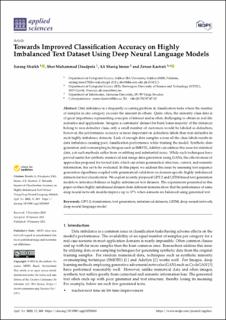| dc.contributor.author | Shaikh, Sarang | |
| dc.contributor.author | Daudpota, Sher Muhammad | |
| dc.contributor.author | Imran, Ali Shariq | |
| dc.contributor.author | Kastrati, Zenun | |
| dc.date.accessioned | 2021-03-08T09:50:29Z | |
| dc.date.available | 2021-03-08T09:50:29Z | |
| dc.date.created | 2021-01-19T12:16:16Z | |
| dc.date.issued | 2021 | |
| dc.identifier.citation | Applied Sciences. 2021, 11 (2), . | en_US |
| dc.identifier.issn | 2076-3417 | |
| dc.identifier.uri | https://hdl.handle.net/11250/2732089 | |
| dc.description.abstract | Data imbalance is a frequently occurring problem in classification tasks where the number of samples in one category exceeds the amount in others. Quite often, the minority class data is of great importance representing concepts of interest and is often challenging to obtain in real-life scenarios and applications. Imagine a customers’ dataset for bank loans-majority of the instances belong to non-defaulter class, only a small number of customers would be labeled as defaulters, however, the performance accuracy is more important on defaulters labels than non-defaulter in such highly imbalance datasets. Lack of enough data samples across all the class labels results in data imbalance causing poor classification performance while training the model. Synthetic data generation and oversampling techniques such as SMOTE, AdaSyn can address this issue for statistical data, yet such methods suffer from overfitting and substantial noise. While such techniques have proved useful for synthetic numerical and image data generation using GANs, the effectiveness of approaches proposed for textual data, which can retain grammatical structure, context, and semantic information, has yet to be evaluated. In this paper, we address this issue by assessing text sequence generation algorithms coupled with grammatical validation on domain-specific highly imbalanced datasets for text classification. We exploit recently proposed GPT-2 and LSTM-based text generation models to introduce balance in highly imbalanced text datasets. The experiments presented in this paper on three highly imbalanced datasets from different domains show that the performance of same deep neural network models improve up to 17% when datasets are balanced using generated text. | en_US |
| dc.language.iso | eng | en_US |
| dc.rights | Navngivelse 4.0 Internasjonal | * |
| dc.rights.uri | http://creativecommons.org/licenses/by/4.0/deed.no | * |
| dc.title | Towards Improved Classification Accuracy on Highly Imbalanced Text Dataset Using Deep Neural Language Models | en_US |
| dc.type | Peer reviewed | en_US |
| dc.type | Journal article | en_US |
| dc.description.version | publishedVersion | en_US |
| dc.source.volume | 11 | en_US |
| dc.source.journal | Applied Sciences | en_US |
| dc.source.issue | 2 | en_US |
| dc.identifier.doi | 10.3390/app11020869 | |
| dc.identifier.cristin | 1874228 | |
| dc.description.localcode | This is an open access article distributed under the Creative Commons Attribution License which permits unrestricted use, distribution, and reproduction in any medium, provided the original work is properly cited. | en_US |
| cristin.ispublished | true | |
| cristin.fulltext | original | |
| cristin.qualitycode | 1 | |

